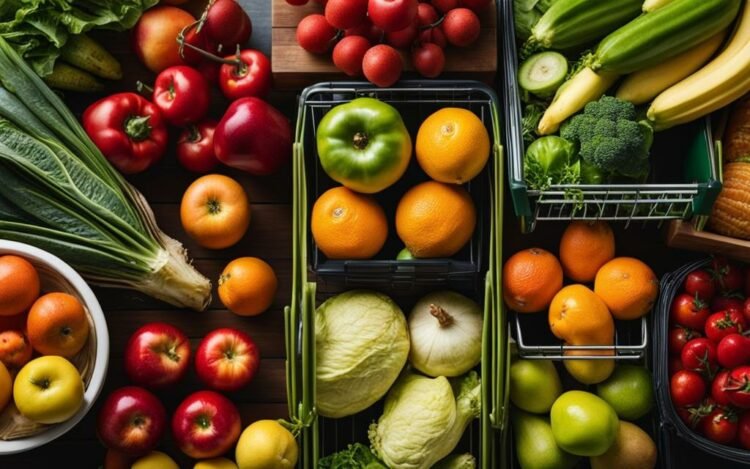Planning meals in advance can have a significant impact on your budget and overall health. By creating a cost-effective and healthy meal plan, you can save money at the grocery store while ensuring that you and your family are enjoying nutritious meals.
In this article, we will provide you with 10 valuable tips to help you create a meal plan that is both budget-friendly and promotes wellness. From making a menu and taking advantage of sales to considering meatless meals, we will guide you through the process of crafting a meal plan that fits your needs and supports your health goals.
Let’s dive into the details and discover how you can transform your grocery shopping experience into a cost-effective and healthy meal plan.
Key Takeaways:
- Create a menu and list the items needed from the grocery store
- Plan meals around foods that are on sale
- Incorporate plant-based meals for affordable protein options
- Utilize pantry ingredients to avoid unnecessary purchases
- Consider grains like rice and pasta for inexpensive and versatile meal options
Check Your Pantry and Make a Shopping List
Prior to heading to the grocery store, it’s essential to take stock of what you already have in your pantry, refrigerator, and freezer. This step ensures that you utilize ingredients that need to be used before they expire, saving you money and reducing food waste. So, open those cabinets and fridge doors, and take note of what you find.
Once you’ve assessed your pantry, make a shopping list based on the ingredients you need to complete your meal plan. A well-planned shopping list helps you stay focused and avoid impulse buys. Consider organizing your list according to the layout of the grocery store to save time wandering through aisles.
If you’re looking to further streamline your shopping experience, consider using a grocery app or online shopping platform that allows you to create and save multiple shopping lists. These tools can help you stay organized and easily add or remove items as needed.
Take Advantage of Sales and Seasonal Options
When creating a cost-effective meal plan, it’s important to keep an eye out for grocery sales and seasonal produce. By taking advantage of these opportunities, you can save money while still enjoying fresh and flavorful ingredients.
1. Check Store Flyers and Newspaper Inserts
Before heading to the grocery store, be sure to check store flyers and newspaper inserts for the latest deals and discounts. These resources often highlight items that are on sale, allowing you to plan your meals around these discounted ingredients.
2. Utilize Online Coupon Sites
Online coupon sites are another great way to find grocery sales and save money. These websites often feature printable coupons or digital deals that can be used at your local supermarket. Make it a habit to browse these sites before you start planning your meals.
3. Incorporate Seasonal Fruits and Vegetables
Seasonal produce tends to be more affordable and abundant. By incorporating fruits and vegetables that are in season, you can add variety to your meals while keeping your grocery bill in check. Plus, seasonal produce is often at its peak freshness and flavor, making your meals even more delicious.
4. Consider Frozen and Canned Options
Don’t overlook the frozen and canned food aisles when you’re on a budget. These options can be a cost-effective choice, especially for items that are out of season or not readily available. Frozen fruits and vegetables are often just as nutritious as their fresh counterparts, and canned goods can be a convenient addition to many recipes.

By taking advantage of sales and seasonal options, you can not only save money but also add variety and nutritional value to your meals. Don’t forget to check store flyers and online coupon sites, incorporate seasonal produce, and consider frozen and canned options when planning your cost-effective meal plan.
Make a Weekly Menu and Consider Meatless Meals
Creating a weekly menu is an essential part of cost-effective and healthy meal planning. By outlining your meals for the week, you can make sure you have all the ingredients you need and avoid last-minute, impulsive purchases. Start by reviewing your meal plan and identifying the recipes that align with your budget and health goals. Consider incorporating meatless meals into your menu to save on the cost of meat. Meatless options like beans, lentils, and tofu are not only affordable but also provide a good source of protein.
When making your weekly menu, take into account the items on sale at the grocery store and ingredients you already have in your pantry. This way, you can optimize your budget and reduce food waste. Plan meals that utilize similar ingredients to maximize cost savings and minimize waste. For example, if you plan to make a stir-fry with vegetables, consider using the same vegetables for a salad or a grain bowl later in the week.
Another tip for budget meal planning is to make larger meals and freeze leftovers. This way, you can enjoy quick and easy meals on busy days without resorting to expensive takeout. Batch cooking and freezing portions not only saves money but also saves time in the long run. Additionally, don’t forget to plan snacks for the week to avoid unnecessary purchases of packaged snacks. Consider options like homemade granola bars, fruit, or yogurt.
Summary:
- Create a weekly menu to plan your meals in advance and avoid impulsive purchases.
- Consider incorporating meatless meals to save on the cost of meat.
- Take advantage of sales and pantry ingredients when making your menu.
- Make larger meals and freeze leftovers for convenient and cost-effective meals.
- Plan snacks to avoid unnecessary purchases of packaged snacks.

Conclusion
Creating a cost-effective and healthy meal plan is essential for grocery shopping on a budget and promoting overall wellness. By following these meal planning tips, you can save money while ensuring a nutritious diet.
Start by making a menu and listing the items you need from the grocery store. Consider planning meals around foods that are on sale and incorporating plant-based options for affordable protein. Take inventory of your pantry, fridge, and freezer to utilize ingredients that need to be used.
Make sure to include budget-friendly grains like rice and pasta in your meal plan and avoid recipes that require expensive special ingredients. Look for seasonal recipes and consider frozen or canned options to keep costs low. Plan to use leftovers for future meals and make extra servings to prevent food waste. Lastly, consider your family’s preferences when selecting ingredients and meals.
By taking advantage of sales and seasonal options, making a weekly menu that includes meatless meals, and planning snacks, you can create a meal plan that fits your budget and supports your health goals. So start planning ahead and enjoy the benefits of a cost-effective and healthy meal plan.
FAQ
How can I check my pantry and make a shopping list?
Before heading to the grocery store, check your pantry, refrigerator, and freezer for items that need to be used. Take note of the expiry dates and look for recipes that incorporate those ingredients. By utilizing what you already have, you can avoid unnecessary purchases and save money. Make a shopping list based on the ingredients you need to complete your meal plan and avoid impulse buys.
How can I take advantage of sales and seasonal options?
To create a cost-effective meal plan, take advantage of grocery sales and seasonal produce. Check store flyers, newspaper inserts, and online coupon sites for good buys. Plan meals around foods that are on sale and consider incorporating seasonal fruits and vegetables, which tend to be less expensive. Frozen and canned options can also be a budget-friendly choice.
How can I make a weekly menu and consider meatless meals?
Create a weekly menu that includes recipes based on your meal plan. Take into account the items on sale and the ingredients you already have. Consider incorporating meatless meals to save on the cost of meat. Eggs can be an affordable protein option. Make larger meals and freeze leftovers for quick and easy meals on busy days. Don’t forget to plan snacks to avoid unnecessary purchases.

